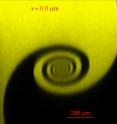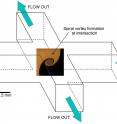Liquid spiral vortex discovered
In many plumbing and pipework systems in general, there are junctions and connections to move liquids such as water in different directions, but have you ever thought about what happens to the water in those fluid intersections? A team of researchers from Okinawa Institute of Science and Technology Graduate University (OIST) and collaborators found an unexpected spiral vortex phenomenon that occurs in the intersections of cross-shaped devices when liquid flows through the channels in a particular way. The team has published their results in Physical Review E. The team moved water through a cross-shaped device, or geometry, by simultaneously pumping water into two channels facing each other, so that they met at an intersection. When the two streams of water meet at the intersection they are compressed by the force of the flow and then extended by being pulled out through the remaining two pathways, creating a spiral vortex in the water.
"On the surface it is a really simple geometry," Prof. Amy Shen of OIST's Micro/Bio/Nanofluidics Unit and author said. "But no one has ever captured or visualized such striking flow structures like this before."
The researchers could visualize this by inserting fluorescent dye into the water that entered from one of the two pathways. Also, the team was able to perform numerical simulations that can predict the spiral vortex phenomenon computationally. When the flow starts up, the spiral can form spinning either clockwise or counter clockwise with equal probability. Through the combinations of the experiments and with the numerical simulations the scientists were able to classify this behaviour as an unusual kind of flow instability.
"We are starting to think that this kind of instability would exist in any kind of intersecting geometry," Dr. Simon Haward, first author and group leader of OIST's Micro/Bio/Nanofluidics unit said.
The team discovered that spirals appear as the flow rate is increased and disappear again if the flow rate is decreased. However, the flow rates corresponding to appearance and disappearance are not necessarily the same. By varying the aspect ratio of the channel, or the depth of the channel divided by its width, they saw differences in how the spiral formed and collapsed. Specifically, with a smaller aspect ratio the spiral would form and collapse again at the same flow rate. But, in devices with large aspect ratios, the spiral collapsed at a lower flow rate than that at which it had formed, exhibiting what is called hysteresis. Interestingly, the team identified a very specific value of the aspect ratio, called a tricritical point, and the growth and collapse of the spiral vortex happens very suddenly over a narrow range of flow rate. All of this information could be useful in understanding and optimizing basic fluid transport processes, predicting fluid instability conditions, and enhancing the mixing of fluids.
"In any channel we can predict when the spiral will form, how big it will grow, and the mixing quality that will result," Haward said.
This could also have implications in other research because "in microfluidic devices it can be difficult to begin the mixing process," Shen said. "Our results suggest that if we make the channel dimensions deeper than it is easier to induce mixing."
Source: Okinawa Institute of Science and Technology (OIST) Graduate University
Other sources
- Researchers discover liquid spiral vortexfrom UPITue, 19 Apr 2016, 16:30:43 UTC
- Unexpected spiral vortex phenomenon found when liquid is pushed through cross-shaped pathwaysfrom Science DailyTue, 19 Apr 2016, 14:40:42 UTC
- Liquid spiral vortex discoveredfrom PhysorgTue, 19 Apr 2016, 12:00:58 UTC

